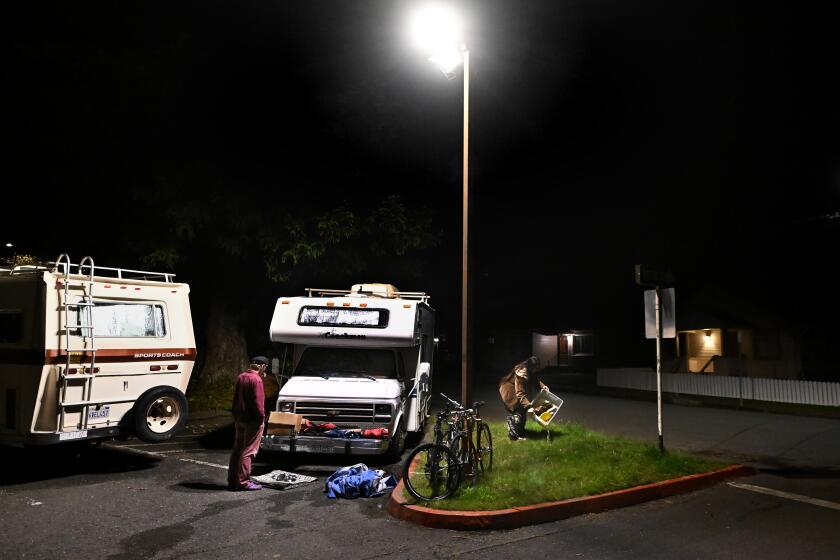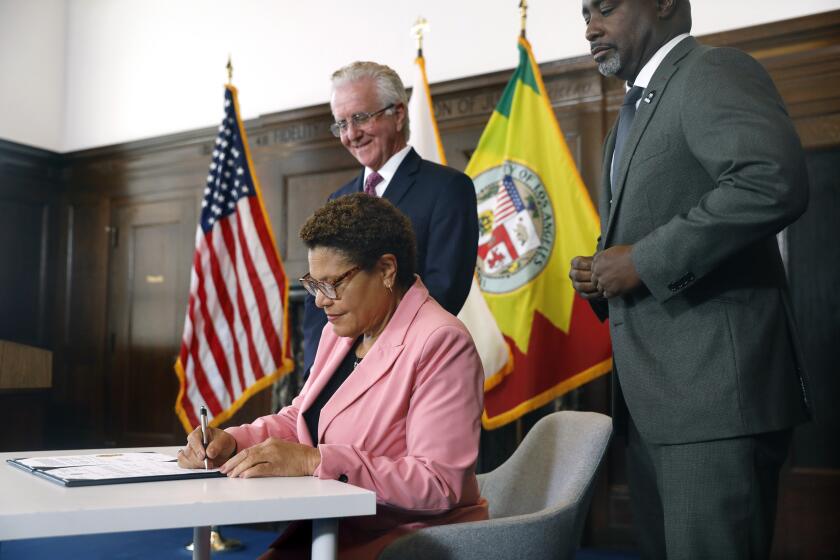Mayor Bass kickstarted more affordable housing in L.A. by cutting red tape. Now the council should make it the law

- Share via
In the city of Los Angeles, where affordable housing is desperately needed and the process of building it is notoriously slow, Mayor Karen Bass came into office last December determined to speed it up.
Her Executive Directive 1 fast-tracked permitting, inspections and utility installations for 100% affordable housing projects. If a developer didn’t need a zoning change, variance or approval from the Coastal Commission, they were good to go. No public hearings. No extensive environmental review. And no NIMBY efforts to stop a project would be allowed.
Homeless college students who live in their cars need safe overnight parking. How tough can that be?
Colleges such as Cal Poly Humboldt resist allowing overnight parking for students who live out of their cars. Long Beach City College shows a better way.
The results of ED1 have been remarkable. It reduced the time to get initial planning permits from six months or longer to an average of 43 business days, according to city officials. And it significantly increased the number of affordable projects being proposed.
As of the end of October, more than 50 fully affordable housing construction projects had been approved and another 55 applications were pending, according to the Planning Department. The mayor’s office says they’re now up to 119 new projects representing about 9,000 units. (The Planning Department estimates as many as 12,383 units — which may include projects already underway when ED1 was adopted that benefited from streamlining during construction or later.) And most of these projects were privately funded, not subsidized by the city.
Editorial: Mayor Bass didn’t end homelessness in her first 100 days. But she made a good start
So far, the Inside Safe initiative has temporarily housed 1,000 people. That’s impressive. The harder part will be getting them into permanent housing.
Now, the City Council is poised to make this directive permanent. It’s the right thing to do.
Of course, we want this enshrined into the municipal code. For years the building process has been bogged down by red tape and community obstruction. And we applaud the mayor for turning this aspect of the city bureaucracy into a fast-acting machine.
But what made the directive attractive to affordable housing developers was not just the streamlining. It was the ability to pair that fast track with the existing state and local incentive programs that allow greater density and let developers adjust setbacks, height and open space requirements.
The proposed ordinance that the council’s Planning and Land Use Management Committee will consider before sending it on to the full council limits how much developers can ask for in terms of density and open space adjustments. But the most meaningful change from Bass’ directive is that it prohibits use of permit fast-tracking in areas zoned for single-family homes.
ED1 didn’t explicitly allow or prohibit its use in single-family zones. And a small number of developers used it to get permits to build in areas that are zoned as single family but are also considered multi-residential by the city’s general plan. (A quirk of L.A. zoning.) The city, realizing what was happening, disallowed those projects in the summer but some developers fought back. Only one appears to be progressing — a 200-unit building project on a huge lot on Ethel Avenue in Sherman Oaks. Councilwoman Nithya Raman took a lot of grief from constituents for supporting the project, but she is right that it would add much-needed housing to the area.
The city might make permanent a directive from Mayor Bass that streamlines development. But in its current form, the policy threatens to make low-income Angelenos homeless.
If the City Council decides to exclude single-family zones from the fast-tracking ordinance, it could still make low-density multi-family zones eligible for developers. Currently, the proposed ordinance prohibits developers from using parcels zoned for less than five units. There are thousands of these low-density multi-family parcels, and according to Abundant Housing LA , a housing advocacy group, allowing their use under the streamlining ordinance is the best strategy to get more affordable housing in a variety of different areas of the city.
Also, the City Council should relax some of the restrictions on setbacks and open space written into the proposed ordinance. We want trees on lots but in a way that makes sense for the lot. A project with a density bonus may not be able to support as many trees as would be required by the new ordinance.
We want affordable housing in every part of L.A., but there is an imbalance in the way it gets built across the city. Unless connected to transit hubs, new construction tends to be clustered in areas where land is cheaper. For example, at least a third of the approved ED1 projects are in South L.A.
“ED1 looks at the process of building affordable housing and that’s all it looks at. Not the whole pie,” said Councilmember Marqueece Harris-Dawson, the chairman of the committee that will weigh in on the proposed ordinance. The proposed ordinance should do more to encourage and provide incentives for affordable housing construction in more affluent communities close to good jobs, schools and other opportunities.
While ED1 was an important first step by Bass, it is not a magic wand. It won’t solve all our housing problems. If we want affordable housing to flourish from South L.A. to West L.A., it will take political will by the mayor and the council to open up single-family neighborhoods to more multi-unit housing.
More to Read
A cure for the common opinion
Get thought-provoking perspectives with our weekly newsletter.
You may occasionally receive promotional content from the Los Angeles Times.












